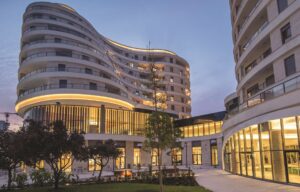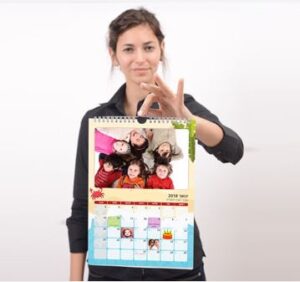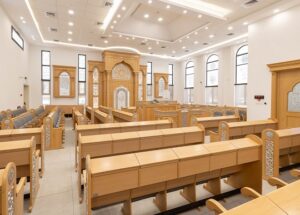In the aftermath of the recent '12 days war' between Israel and Iran, a hush fell over the travel world, but Vienna is quietly reawakening. For Jewish travelers, it offers more than beauty: it promises kosher food, daily minyanim, and rich heritage. History shows that after every travel freeze comes a wave of “revenge travel”- a thirst to breathe foreign air again. When that moment comes, many will choose places that nourish both body and soul. With its imperial grace and deep Jewish legacy, Vienna stands ready to welcome them.
Schönbrunn Palace: Echoes of Empire

Start your visit at Schönbrunn Palace, Vienna’s crown jewel and a testament to baroque excess. The palace gardens stretch like embroidered green tapestries. Sculpted lawns, symmetrical flowerbeds, marble fountains gushing cool water, and white statues peeking shyly from the hedges.

There’s even a labyrinth for the romantics. And for the children, the world’s oldest zoo, with wrought-iron cages that whisper of old-world nostalgia.

Inside, the palace chambers drip with opulence: golden wallpaper, painted ceilings, and chandeliers heavy with crystal. In the Children’s Museum, kids can dress up in velvet waistcoats and tulle gowns, brushing against the fantasy of royalty for just an hour.
The Burgtheater: Where Legends Gaze Down

At the Burgtheater, myth and history loom from above. Greek gods and Austrian thinkers are frozen mid-thought on the façade, staring silently down at modern pedestrians. Step inside, and you're enveloped in aristocratic splendor: red velvet curtains, gilded walls, vaulted ceilings painted with allegory, and chandeliers that glow like captured starlight.
Hofburg Palace and the Spanish Riding School

The Hofburg, once the winter residence of the Habsburgs, is a sprawling complex of white stone and oxidized copper roofs. Fountains echo in the courtyards. Statues pose along the walls with such kinetic energy, you’d swear they might turn and speak.

Tucked within the Hofburg is the Spanish Riding School, where the famed Lipizzaner stallions glide in silence across the arena. Beneath crystal chandeliers and stark white walls, these horses perform ballet. Children stare open-mouthed. Adults, too.
Prater Park: Vienna's Whirling Heartbeat

For a shift in tempo, head to Prater Park, the city’s beloved amusement playground. Here, old-world charm meets carnival wonder. The towering Giant Ferris Wheel, one of Vienna’s most iconic landmarks, spins slowly, offering panoramic views that feel as timeless as the Danube.
St. Stephen’s Cathedral

In the very heart of the Old City, St. Stephen’s Cathedral rises like a prayer in stone. Its mosaic roof of colored tiles is one of the most beautiful sights in Austria. For those comfortable entering churches, climb the 343 winding steps to the observation deck. The view? All of Vienna at your feet. Red rooftops, baroque domes, the shimmer of the river. Every breath stolen by the climb is returned in wonder.
A Jewish Journey Through Vienna
Beneath the city's imperial shimmer and the lilting waltzes that still echo from concert halls and cafés, lies a deeper melody. One composed of centuries of Jewish life, love, faith, and grief. Vienna, with its wide boulevards and marble façades, holds within its stone bones the traces of a Jewish civilization that once pulsed vibrantly here. Before the Holocaust, there were more than 90 synagogues across the city, each a testament to a community deeply rooted and culturally alive. Today, only a few have survived the darkness.

One of them is the Stadttempel, hidden in plain sight in the First District. During the reign of Emperor Joseph II, Jews were forbidden from building synagogues with outward grandeur. And so, from the street, the Stadttempel looks deceptively modest. Its entrance nestled quietly between apartment buildings, as if trying not to draw attention. But the moment you cross its threshold, you step into another world.

The sanctuary opens like a revelation: curved walls wrapped in soft golden light, balconies for the women’s gallery rise like opera boxes, and an enormous crystal chandelier glows from the heart of the high dome, casting prisms of light onto the velvet blue Ark below. The carvings are delicate, the acoustics intimate, the silence charged with sanctity.
To attend a Shabbat service here is to be swept into something greater than yourself. The cantor's voice, backed by a professional choir, lifts the prayers until they seem to hover mid air. The melodies, sung in Vienna version (Nusach Vina), a rare liturgical tradition similar to Ashkenazi version, but wholly unique to this city, evoke a time when Vienna was one of the beating hearts of European Jewry. There’s even a siddur printed in this nusach, used nowhere else in the world. Here, prayer becomes performance, and tradition, a living concert.

Step outside after the service, and look down the street. Two low concrete posts still stand, linked by a chain. Before the war, this chain was drawn across the road on Shabbat, halting traffic so that the peace of prayer could remain unbroken. It's a small detail, but one that pulses with meaning, a relic of the rhythms that once shaped Jewish life here.
A short walk away brings you to Judenplatz, the Jewish Square. A place where the silence speaks. On the second floor of number 8 is a modest Sephardic synagogue where I once prayed during my time in Vienna.

It shares the building with branches of Bnei Akiva and Mizrachi, reminders that the story here is not only of destruction, but also of continuity. Centuries ago, this square was home to Vienna’s Jewish ghetto. Today, its very stones seem to breathe memory.

At the center stands the chillingly beautiful Nameless Library. A Holocaust memorial like no other. Sculpted from concrete, it takes the form of a library with books turned backward, their spines facing inward, their titles unreadable, stories forever lost.

At its base are marble plaques engraved with the names of the death camps: Auschwitz. Mauthausen. Treblinka. A litany of loss, carved into stone.
And beneath your feet lie deeper echoes. In 1995, archaeological excavations unearthed the ruins of the medieval synagogue 'Or Zarua', once a haven of learning and spirit. In 1421, when Jews were ordered to convert or die, hundreds sought refuge inside. After three days under siege, the community’s rabbi lit the synagogue ablaze, choosing death over forced baptism.

Their martyrdom is commemorated on a plaque at the far end of the square. Its chilling Latin inscription reads: “The River Jordan purifies the body of illness, evil, and sin. And so in 1421, the streets burned to reveal the monstrous crimes of the Jewish dogs.” The venom still clings to the words.
The air here is heavy, almost sacred. Even the cobblestones seem to remember. Above the ruins of 'Or Zarua', a subterranean Jewish museum now stands, dedicated to Jewish life in Vienna from the 14th century to today. Its entrance is discreet, through the same corner building that houses the Bnei Akiva branch. It is a descent into history. One that feels more like a pilgrimage than a museum visit.

But Vienna’s Jewish memory does not end here. Just a short walk away is Palais Eskeles, home to the city's first Jewish museum. This aristocratic mansion, draped in classical arches and regal restraint, now tells a different story: the story of Jewish creativity, culture, and courage. Inside, gleaming display cases hold ceremonial artifacts—silver kiddush cups, embroidered Torah mantles, and fragments of a world that once danced with light. One room is devoted entirely to the post-Holocaust rebirth of the community: a quieter narrative, perhaps, but one no less vital. A story of return, rebuilding, and resilience.

Vienna’s Jewish presence is not just carved in stone or hidden beneath the ground. It is felt-in the hush of ancient prayer halls, in the scent of old books, in the shadows of memorials and the laughter of children climbing synagogue steps once again. For those who listen closely, the city still sings.
The original Jewish ghetto of Judenplatz was destroyed in the pogrom of 1421. After centuries of rebuilding and return, the Jewish population gravitated eastward across the Danube Canal, settling in the second district of Vienna, called Leopoldstadt, now known as "The Jewish quarter".
Today, Leopoldstadt is home to numerous synagogues, Jewish schools, mikvehs, and a rich kosher scene in Vienna, including restaurants, cafés, and Judaica shops. The Chabad House on Taborstrasse serves as both an anchor and a haven for Jewish visitors and locals alike. With tourism reshaping the neighborhood, souvenir shops have popped up beside old-world bakeries, blending commerce with culture.
Where Memory Stands Tall and Silent
But even among the living, the past persists. The once-majestic Great Synagogue of Leopoldstadt, inaugurated in 1858, was a marvel of Jewish architecture. A landmark that drew admirers from across Europe.

On Kristallnacht in 1938, it was reduced to rubble. Today, three white metal high pillars rise quietly from the earth, like sentinels of memory. They stand not as replicas, but as witnesses. Across the street, the offices of the Jewish community and the Ezra youth movement preserve the memory with a commemorative plaque and stories passed down in whispers.
The Eternity: The Old Jewish Cemetery

Farther west, in the 9th district, lies a place where time still breathes: The Old Jewish Cemetery, opened in 1540. The gravestones, some cracked, others leaning gently, date from the 16th to 18th centuries. Among the moss and wildflowers rest Rabbi Shimon Oyerbach, Rabbi Menachem Hendl, and Samuel Oppenheimer, the financier who helped fund the Austrian empire. The cemetery was recently restored in an effort to halt the erosion of history. It stands today as a quiet island of eternity in a city that never stops changing.
Hidden Traces of Jewish Vienna
But Jewish Vienna isn’t just confined to squares, museums, and monuments. Its traces are scattered across the city, waiting to be noticed. Embedded in sidewalks are Stolpersteine, small, brass cobblestones placed in front of homes where Jews once lived. You walk, then stop. Below your feet, a name, a birthdate, a deportation date, a death date. Each one is a private monument, a soul sized memory.
One of the most poignant memorials in Vienna is the small, easily overlooked statue known as The Rabbi Street Sweeper. It portrays a Jewish man on his knees, scrubbing the sidewalk with a brush stripped of its handle, his hands bound with barbed wire. This was no artistic exaggeration. It reflects the real horrors of 1938, when the Nazis forced Vienna’s rabbis to clean the city’s streets, not standing, but crawling in humiliation, under the watchful gaze of a jeering public.

Among them was Rabbi Aaron Friedman,family of the Sadigura Rebbe. In those agonizing moments, he made a vow in his heart: "If I ever merited to reach the Land of Israel, I would sweep its streets willingly". He survived. He made aliyah. And each morning, just before the vatikin sunrise prayer, he would step outside his modest home on Nachmani Street in Tel Aviv and quietly sweep the sidewalk. Not as a chore, but as a prayer.

And then there are the Herzl Stairs, rising near the home of Theodor Herzl, the father of political Zionism. A plaque marks the spot and honors his fierce, improbable dream of a Jewish state.
The stairs climb gently to Desider Friedmann Square, named after one of Vienna’s most prominent Zionist leaders, a man whose voice once stirred hope from pulpits and podiums, and who was ultimately silenced in Auschwitz. His name now rests quietly in a city that once cheered his dreams and later watched his community vanish.

Just a short distance away, on a shaded residential street at 19 Berggasse, stands a building that breathes in whispers: the Sigmund Freud Museum. It was here, in these modest rooms, that the father of psychoanalysis unearthed the darkest chambers of the human psyche. During the rise of the Nazis, Freud fled to London, but the apartment he left behind has remained almost untouched, like a pause in history.

The famous psychoanalytic couch is remains, and small antiquities, oriental paintings, and the almost eerie persistence of Freud’s spirit. The scent of aged wood, velvet chairs, and yellowed newspapers lingers in the air. Walking through the space, you feel him still, an invisible host in his own museum, just having stepped out for a cigar, as if he might return at any moment to finish a thought on dreams, desire, or death.
Ringstraße and the Lost Jewish Grandeur
Scattered across Vienna’s grand Ringstraße, behind wrought iron balconies and frescoed ceilings, lie what were once the private palaces of Vienna’s elite Jewish families. These “Ringstraße Palaces” with names like Palais Gutmann and Palais Wertheim, are not simply buildings. They are monuments to a golden era, when Jewish entrepreneurs, bankers, and intellectuals helped shape the very identity of the city.
Strolling down the Ringstraße today, with its trams humming and carriages clattering past, you’re walking through echoes of forgotten dynasties. The facades are still ornate, the marble still cool to the touch, but the families, the laughter, the Seder tables, the salons of debate and poetry, all gone. Each palace tells a story of ambition, refinement, and tragic disruption.
Modernism Against Empire
One building stops you in your tracks. Not for its opulence, but for its audacity. The Loos House, just opposite the Hofburg Palace, is considered the birthplace of modern Viennese architecture. Designed by Adolf Loos for the Jewish entrepreneur Leopold Goldman, the building was a direct affront to Habsburg tastes. The emperor reportedly closed his blinds in protest, offended by its brutal minimalism.
But step inside, and it tells another tale: ornate columns, intricate mosaic floors, and that unmistakable scent of leather bound books, velvet curtains, and quiet defiance. This was not just a store—it was a manifesto in stone, an architectural revolution born of Jewish vision.
Names in Stone, Songs in Silence
Near Vienna’s City Hall, in a leafy park dusted with chestnut petals, stands a lesser-known statue: Joseph von Sonnenfels, a Jewish jurist, reformer, and friend of Mozart, commemorated with calm dignity. A man of law, reason, and light. His figure now frozen in a city that once tried to erase such names from its memory.
A few districts away, another kind of monument stirs quieter echoes. The Ottakringer Brewery, Vienna’s largest, was Jewish-owned from 1850 until the Holocaust. It brewed more than beer. It brewed generational wealth, philanthropy, and civic pride. In 1938, the Nazis confiscated it and handed it over to non-Jewish owners. For decades, this fact remained buried, unspoken. Only recently has a modest plaque been installed, acknowledging the Jewish family that once stood at its helm.
For travelers seeking meaningful Jewish experiences in Vienna, these sites are not just stops on a walking tour. They are thresholds into memory. And as you move from palace to museum, from Freud’s flat to the Loos House, you begin to realize that Vienna is not only a city of imperial façades and café conversations. It’s a cemetery of brilliance, and a fragile archive of souls who dreamed, danced, studied, suffered, and endured.
Vienna for the Kosher Traveler
Here is a useful list of places to help you enjoy a more relaxed and kosher friendly visit to Vienna, more so than in many other European destinations:
Active synagogues:
In a city that once reverberated with the sounds of ninety synagogues before the Shoah, today’s active prayer houses stand as proud remnants and resolute continuations. Most of these synagogues hold three daily minyanim on weekdays and Shabbat, and offer a welcoming atmosphere for visitors from around the world. Here is a partial list of Vienna's active synagogues:
- Mizrachi– Judenplatz 8
- Chabad House – Taborstraße 20a
- Sephardic Caucasus Synagogue – Novaragasse 7
- Russian Synagogue – Tegetthoffstraße 3a
- "Beit HaLevi" Bukharian Synagogue – Rabbiner Schneerson Platz 2
- Machzikei HaDath – Große Mohrengasse 19
- Agudat Yisrael– Grünangergasse 1
- Kahal Hasidim – Große Schiffgasse 8
- Ohel Avraham at the Lauder Campus – Hofzeile 18
Where to Eat Kosher in Vienna
- Near the Stadttempel you’ll find the restaurant Alef Alef (Seitenstettengasse 4), a place where the veal schnitzel is the best I've ever tasted.
- Bachur Tov – Taborstraße 19, just across Chabad House.
- Tzfat – a newly opened spot on Kleine Sperlgasse 6
- Meah She'arim – Schmelzgasse 3.
- Novellino – a chic Italian dairy restaurant, Zirkusgasse 15
- LOX & TRUFFLES – a boutique dairy deli with fresh bagels and fish dishes, Steindlgasse 6
- Prego Pizzeria – Taborstraße 43,
- Rustico Napoletana Pizzeria – Rotensterngasse 3.
- Ohel Bakery & Café – Lilienbrunngasse 18, a soft, warm stop for coffee and pastries
Kosher Supermarkets and Delis:
Vienna’s kosher supermarkets make it easy for religious travelers to stock up like locals.
- Shefa Supermarket – Heinestraße 24–26: Fully stocked with everything from Israeli hummus to Hungarian pickles.
- LeMehadrin Supermarkets – Two locations (main branch on Taborstraße, another on Kleine Sperlgasse). These places are goldmines: products imported from Israel, friendly Hebrew-speaking staff, and even free delivery to hotels and rentals.
- Kosher Deli – Kleine Sperlgasse 7
- Bernadette Einhorn Glatt Kosher Deli – Große Stadtgutgasse 7
Kosher Hotels in Vienna:
Yes, even your hotel can echo your values. The Hotel Stefanie, a stately property with old-world charm, offers a truly unique option: “The Chafetz Chaim’s Room”, once used by the revered rabbi during a visit to Vienna over a century ago. I stayed there myself. The mattress was new, but the air felt ancient, filled with whispers of prayer and parchment
Jewish Vienna: Layers Beneath the Waltz
What makes Jewish heritage in Vienna so poignant is not only what was lost, but what remains hidden in plain sight. It’s in the stoic palaces with shuttered windows, the perfume of Freud’s old books, and the quiet humility of a statue in a park. It’s the tension between what was and what could have been.
Pictures credit: Jacob Maor, Wikimedia Commons, Anton Kurt, and Herta Ornaus.











